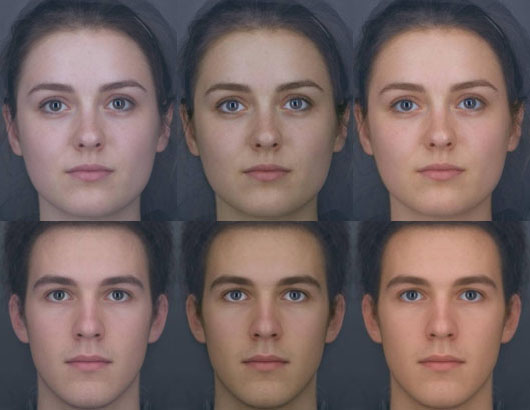Looking good on greens
Eating a healthy diet rich in fruit and vegetables gives you more healthy golden glow than the sun, say scientists.
The new research, by psychologists at the University of St Andrews, suggests that instead of hitting the beach, the best way to look good is by munching on carrots and tomatoes.
The team at the Perception Lab at St Andrews found that people who eat more portions of fruit and vegetables per day have a more golden skin colour, thanks to substances called carotenoids. Carotenoids are antioxidants that help soak up damaging compounds produced by the stresses and strains of everyday living, especially when the body is combatting disease. Responsible for the red colouring in fruit and vegetables such as carrots and tomatoes, cartenoids are important for our immune and reproductive systems.

Images show ‘natural’ faces alongside the differences between the effects of exposure to the sun versus intake of carotenoids.
Dr Ian Stephen, who led the research, commented, “Most people think the best way to improve skin colour is to get a suntan, but our research shows that eating lots of fruit and vegetables is actually more effective.”
“We found that, given the choice between skin colour caused by suntan and skin colour caused by carotenoids, people preferred the carotenoid skin colour, so if you want a healthier and more attractive skin colour, you are better off eating a healthy diet with plenty of fruit and vegetables than lying in the sun.”
Dr Stephen, now at the University of Nottingham Malaysia Campus, suggests that the study is important because evolution would favour individuals who choose to form alliances or mate with healthier individuals over unhealthy individuals.
“This is something we share with many other species,” commented Professor David Perrett, who heads the Perception Lab. “For example, the bright yellow beaks and feathers of many birds can be thought of as adverts showing how healthy a male bird is. What’s more, females of these species prefer to mate with brighter, more coloured males. But this is the first study in which this has been demonstrated in humans.”
While this study describes work in Caucasian faces, the paper also describes a study that suggests cross cultures since similar preferences for skin yellowness were found in an African population.
The work was funded by the Biotechnology and Biological Sciences Research Council (BBSRC) and Unilever Research, and published with support from the Economic and Social Research Council (ESRC) and the British Academy and Wolfson Foundation.
It is published in the journal Evolution & Human Behavior this week.
Contacts
- Ian Stephen ([email protected])
- David Perrett ([email protected]) 01334 463044
See http://perception.st-and.ac.uk/ or Perceptionlab.com for demos or to participate in face experiments.
Ends
Issued by the Press Office, University of St Andrews
Contact Gayle Cook, Senior Communications Manager on 01334 467227 / 462529, mobile 07900 050 103, or email [email protected]
Ref: Looking good 100111
View the latest University press releases at www.st-andrews.ac.uk
Category Research